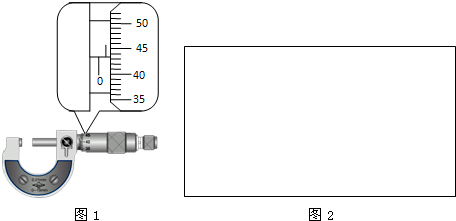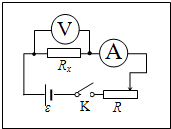某同学在一次“测定金属的电阻率”的实验中,用米尺测量金属丝的接入长度为l,用螺旋测微器测量金属丝直径(刻度位置如图1所示),用伏安法测出金属丝的电阻(阻值大约为6Ω),然后根据电阻定律计算出该金属材料的电阻率.

在用伏安法测定金属丝的电阻时,除被测电阻丝外,还有如下实验器材:
A.直流电源:电动势约3V,内阻很小;
B.电流表A:量程0~0.6A,内阻约为0.125Ω;
C.电压表V:量程0~3V,内阻约3kΩ;
D.滑动变阻器:最大阻值20Ω;0.5A
E.开关、导线等.
(1)从图中读出金属丝的直径d为______mm;
(2)根据所提供的器材,在如图2所示的方框中画出测定金属丝电阻率的实验电路图;
(3)若根据伏安法测出电阻丝的阻值为R,则这种金属材料的电阻率的表达式为______.
(1)从图中读出金属丝的直径为d=0.5mm+43.5×0.01mm=0.935mm
(2)因测量金属丝的电阻率电流不能太大,由I=
结合电流表读数原理,电流表应满足偏转一半以上,故总电阻大于10Ω小于5Ω,可见滑动变阻器可以用限流式;由于待测电阻的电阻值较小,电流表应用外接法,电路图如图所示;E R+r

(3)根据欧姆定律,有:R=
;U I
根据电阻定律,有:R=ρ
;L S
其中:S=
πd2;1 4
所以 ρ=
.πRd2 4l
故答案为:(1)d=0.935;(2)电路图如图所示;(3)表达式 ρ=
.πRd2 4l
